|
synt.model
Figure 1 Synthetic model. From top to bottom, slowness model, reflectivity model and the zero offset section of the modeled 2D prestack data. | 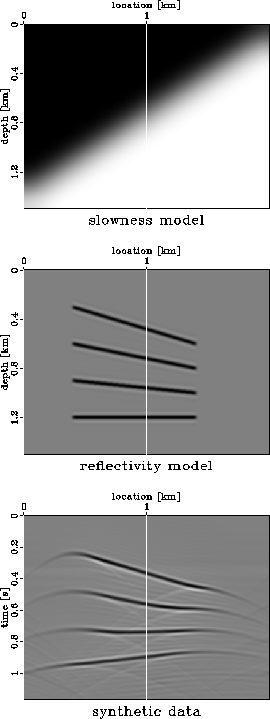 |
The first example is a simple 2D model with a 4 dipping reflectors embedded in a velocity model which varies smoothly both as a function of horizontal position and as a function of depth. synt.model shows, from top to bottom, the slowness model, the reflectivity model and the zero offset of the 2D modeled data. The data were generated with a wavefield-continuation operator (24; 82; 86). The maximum offset of the simulated data is 2.56 km, and the velocity ranges between 2.0 km/s in the upper left corner to 2.4 km/s in the lower right corner.
|
synt.model
Figure 1 Synthetic model. From top to bottom, slowness model, reflectivity model and the zero offset section of the modeled 2D prestack data. |  |
To test the prestack Stolt residual migration, I migrate the synthetic data using wavefield-continuation with the mixed-domain split-step Fourier method. The tests are carried out using two velocity models: the correct velocity, and an incorrect velocity model which is obtained from the correct one by scaling with a factor of 0.8.
synt.RC.zhm shows the image obtained using the correct velocity model. The left panel represents the zero offset section of the image obtained by 2D prestack downward-continuation migration. The right panel represents a common image gather in the angle domain (adcig), extracted at the horizontal location x=1 km.
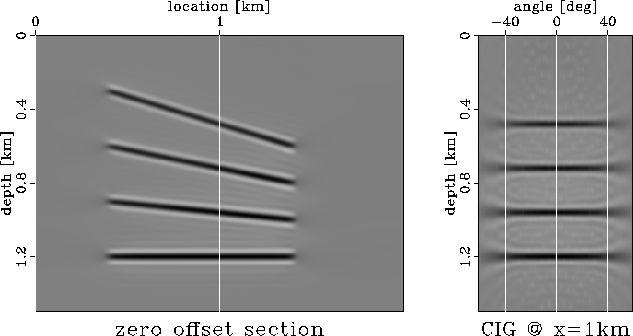 |
synt.R0.zhm shows the image obtained using the incorrect velocity model. Since this velocity is smaller than the correct one, the image is strongly undermigrated, and the events in the angle-domain common image gathers bend strongly upward.
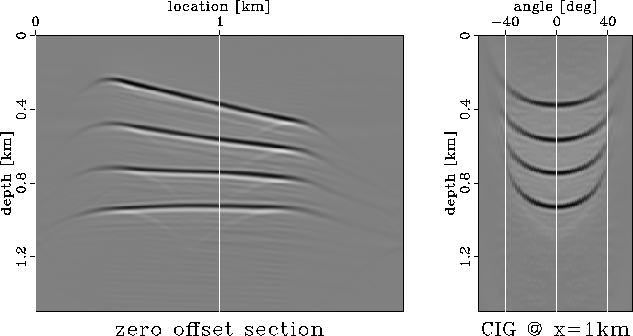 |
synt.R0.srm shows the result of applying Stolt
residual migration using the correct velocity ratio (![]() )
to the
undermigrated image in synt.R0.zhm. The result
is a well focused image, with reasonably flat
angle gathers. This result shows that, although only approximate for
variable velocity media, the method outlined in this section
can successfully operate on depth migrated images
despite the assumption of constant velocity made in the derivation.
Of course, there is no guarantee that the method will be successful
on arbitrary velocity models. However, on fairly smooth models,
Stolt residual migration can at least indicate the
direction of the changes that improve the migrated image.
)
to the
undermigrated image in synt.R0.zhm. The result
is a well focused image, with reasonably flat
angle gathers. This result shows that, although only approximate for
variable velocity media, the method outlined in this section
can successfully operate on depth migrated images
despite the assumption of constant velocity made in the derivation.
Of course, there is no guarantee that the method will be successful
on arbitrary velocity models. However, on fairly smooth models,
Stolt residual migration can at least indicate the
direction of the changes that improve the migrated image.
 |
The second example concerns a real dataset from a complex salt dome region in the North Sea (111). This dataset was donated to SEP by Elf and it is part of the SEP data library. saltreal.raw shows a zero-offset section obtained by 2D prestack downward-continuation migration. We can clearly distinguish the salt body and the sediment layers. However, the area under the salt overhang is not imaged correctly, mostly due the inaccuracies in the velocity model (111).
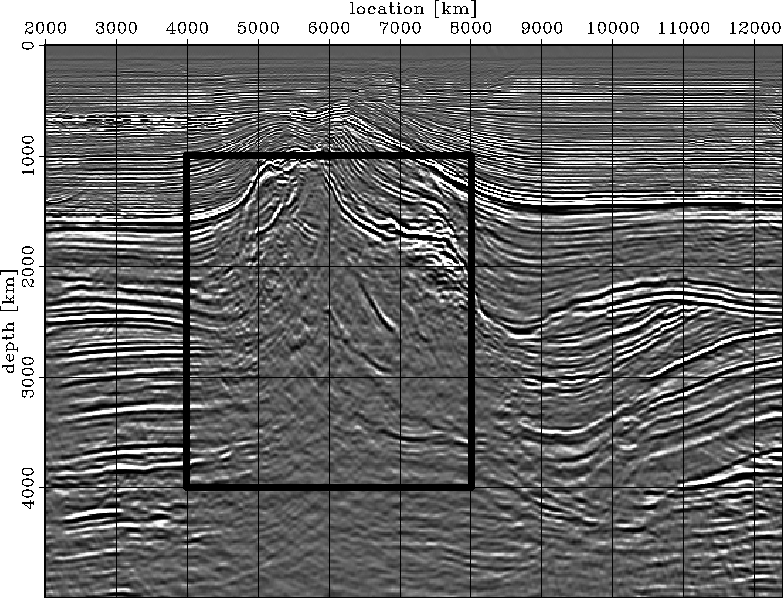 |
The errors in this image are too complex for a simple algorithm like the one outlined in this section to be fully successful. We cannot hope to recover the exact structure under the salt overhang just by residual migration. However, we can use the speed of such an algorithm to investigate whether any other piece of the image can be brought in focus, and to determine roughly in which direction we need to modify the velocity model.
saltreal.srm shows the result of residual migration.
Each one of the 9 panels corresponds to the box depicted in
saltreal.raw. The images are obtained for various values
of the parameter ![]() ranging from
ranging from ![]() to
to ![]() as labeled in the figure.
as labeled in the figure.
We can observe several things:
the top of salt, which was not well focused in the original image
(![]() ), is better focused in some of the panels corresponding to
lower values of the parameter
), is better focused in some of the panels corresponding to
lower values of the parameter ![]() ;the salt overhang is brought into much better focus,
particularly in the panel corresponding to
;the salt overhang is brought into much better focus,
particularly in the panel corresponding to ![]() around
x=6000 and z=3000;
the sediments that are practically
impossible to track in the original image are more coherent
and can be traced much deeper under the salt overhang on the image
corresponding to
around
x=6000 and z=3000;
the sediments that are practically
impossible to track in the original image are more coherent
and can be traced much deeper under the salt overhang on the image
corresponding to ![]() .
.
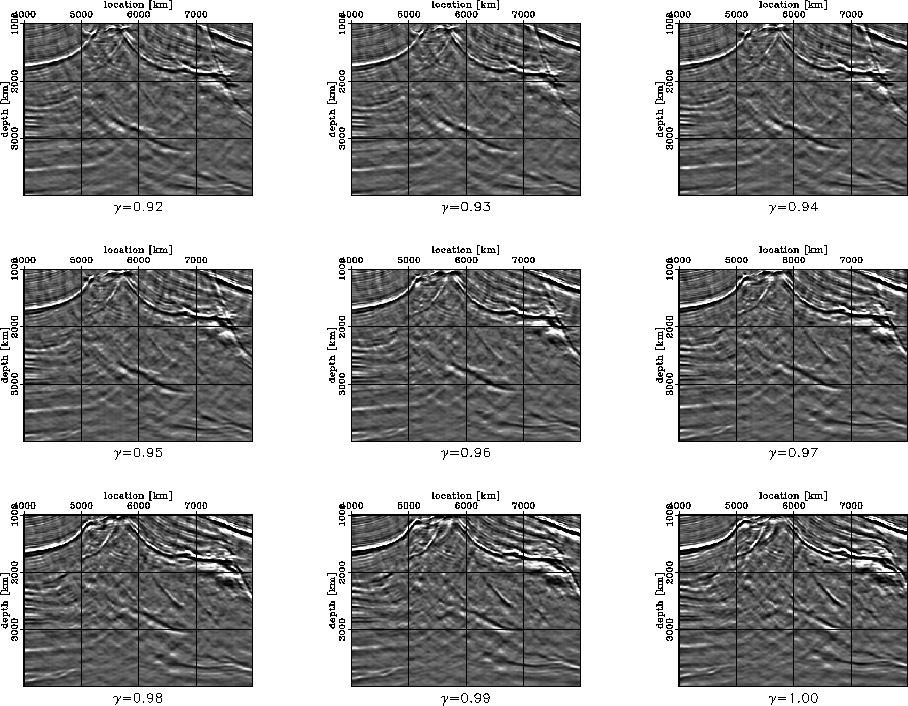 |
saltreal.constant is a comparison between
the original image (![]() , top panel) and the image
obtained by prestack Stolt residual migration that best resolves the salt
overhang and sediments underneath (
, top panel) and the image
obtained by prestack Stolt residual migration that best resolves the salt
overhang and sediments underneath (![]() , bottom panel).
For comparison, the middle panel shows
an image obtained by residual moveout which also shows an improvement
over the original image, but not as good as the one obtained by residual
migration. This is understandable, since residual moveout does
not allow energy to move between midpoints, while residual migration does.
, bottom panel).
For comparison, the middle panel shows
an image obtained by residual moveout which also shows an improvement
over the original image, but not as good as the one obtained by residual
migration. This is understandable, since residual moveout does
not allow energy to move between midpoints, while residual migration does.
|
saltreal.constant
Figure 7 A comparison of the original image (top panel) with the improved images obtained by residual moveout (middle panel) and the image after residual migration with a constant velocity ratio parameter | 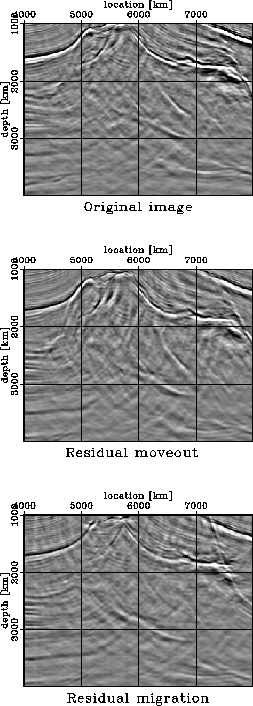 |
Finally, if we carefully analyze the images in saltreal.srm,
we can observe that various parts of the image are in good focus at different
values of the ratio parameter ![]() . This leads to the conclusion that
none of the panels in saltreal.srm alone can serve as an
improved image at all locations in the image. One possible solution
to this problem is to create a smooth interpolation map which slices
through the various images at different values of
. This leads to the conclusion that
none of the panels in saltreal.srm alone can serve as an
improved image at all locations in the image. One possible solution
to this problem is to create a smooth interpolation map which slices
through the various images at different values of ![]() for every location
in the image. saltreal.variable shows such a result:
the top and middle images are respectively the original and improved images for
variable
for every location
in the image. saltreal.variable shows such a result:
the top and middle images are respectively the original and improved images for
variable ![]() , and the bottom panel is the interpolation map used to extract
the middle panel.
, and the bottom panel is the interpolation map used to extract
the middle panel.
|
saltreal.variable
Figure 8 A comparison of the original image (top panel) with the image obtained by residual migration (middle panel) with a spatially varying | 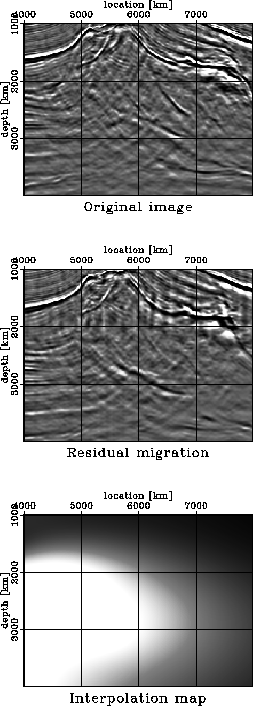 |